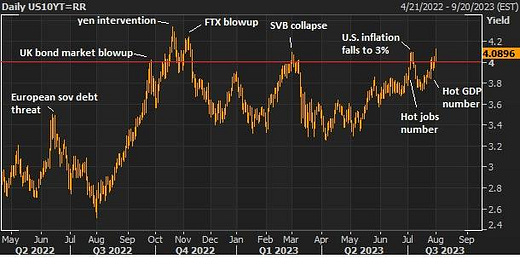We are back in the "danger zone" for the 10-year yield - it was driven here by a hot GDP number last week.
We've looked at this chart below many times - the 4% level has been trouble for financial stability, and has resulted in intervention.
The exception was last month when it was resolved by an inflation number that came in at 3%, the lowest since 2021, allowing yields to fall back comfortably under 4% and out of the danger zone.
Now we have another inflation data point coming (next week), and rates are in a similar spot. It won't be 3%. But it should be in the 3s. Good enough. And expect the focus to return to the "core" number (excluding what was a sharp rise in oil prices last month).
Related to this chart, we've talked about the Bank of Japan's role in keeping our 10-year yield in check, through its (continued) unlimited QE program - (among many global and domestic assets, they purchase U.S. bonds, which puts downward pressure on U.S. rates).
Importantly, they tweaked this program last week, which changed the triggers for their unlimited bond buying program.
Does it change the game? No. They are still buyers of bonds in unlimited amounts, and perhaps at an even more aggressive pace, given their new flexibility of where they will allow the Japanese Government Bond yield to trade.
To be sure, the global central banks, in coordination, are still in control of the government bond markets.





